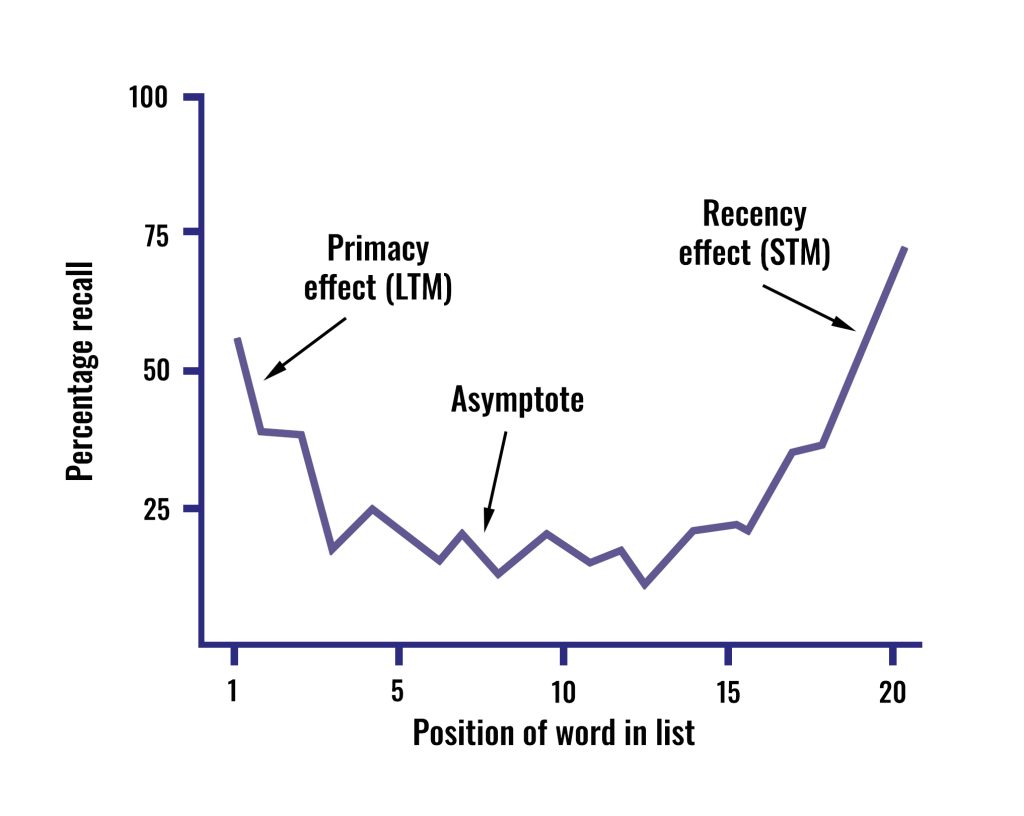
I hope you get value out of this blog post.

The serial position effect states that “users have a propensity to best remember the first and last items in a series.” For UX designers, the idea is that the most important points—or the details that you want to call a user’s attention to should be at the top or bottom of a page.
But even outside of web design, the human brain has a natural tendency to recall the first and last items in a sequence most clearly. In studies where participants were given a list of words and then asked to recall them later, they were most likely to recall the first few words and last few words on the list.

As a financial advisor, that means that regardless of whether you’re speaking to your client or writing them an email, the client is most likely to remember what you said at the start and at the end of a meeting or email—and least likely to remember what was said in the middle.
There are two related phenomena that could account for this tendency: the primacy effect and the recency effect.
The primacy effect refers to the fact that it’s easier for the brain to store smaller chunks of information in long-term memory. So those first few items on a list get quickly processed and stored. But by the middle of the list, the brain starts to struggle with information overload.
The recency effect refers to the fact that, before information gets stored in the brain’s long-term memory, it’s held briefly in the short-term memory. This short-term memory can handle around seven items at a time. So those items at the end of the list are recalled well simply because they’re still sitting there in the person’s short-term memory (but they haven’t yet been processed into long-term memories yet).
Understanding when and how the brain processes and stores information has major implications for how you communicate with your clients. If clients are struggling to remember the advice you’re giving them or forgetting to take the important next steps to act on that advice, this can hurt the value they’re getting (and perceiving) from your service.
Knowing that the first and last points are the most likely to stick, however, you can make sure you’re structuring your meeting agendas and emails in a way that optimizes how much your client remembers.
The key lessons to take away from this UX design law include:
Here are five ways to use that knowledge of how human memory works to get the most out of your meetings and communications with clients.
To get the most out of your meetings while accounting for the way human brains process and store information, make sure to organize your meeting with the most urgent and important topics upfront and the second most important topics at the end.
You can use the middle of the meeting for:
The division won’t always be so clear-cut since there’s rarely going to be a topic that you think, “well, it’s fine if they forget this entirely.” Instead, try to think about how soon they need to remember it or take action on it.
Jumpstart their memory by sending that agenda you created to them via email ahead of the meeting. Even if all they do is give it a quick glance, it’ll ensure that those items already start the process of becoming long-term memories even before the meeting starts.
Sending out meeting agendas is also a great way to make sure clients remember to bring any necessary documents with them or recall any questions or topics they wanted to bring up.
You can’t always pack all the important and urgent details into the beginning and end of a meeting. Sometimes, there’s just too much ground to cover. Sending a follow-up email with a quick summary of what you discussed and what next steps need to be taken can help counteract the serial position effect and increase the amount of information your clients take away from your meetings.
For maximum optimization, put any actions they need to take—like sending over documents or contacting their tax preparer—at the end of the email. Even better: separate them from the rest of the text and use bold font to draw their attention to them.
Don’t write an essay. Write a bullet-point summary. It’s easier for the brain to process smaller pieces of information than longer ones so an easy-to-read list of key points will get absorbed by the client’s memory more effectively than a long-winded, meticulously detailed email.
To help reinforce the client’s memory even further, you can swap the order of the items. Put the first points from the meeting at the bottom and the last points from the meeting at the top. This way, those last points which might still just be stored as short-term memories are more likely to get moved into long-term storage—increasing the total amount of information that your client remembers in the long term.
The more opportunities you create to refresh and remind your clients about their finances and the services your providing, the stronger and more detailed their memory will be. With everything else going on in their lives, it’s easy for memories of what you did early in the year to fade and to lose sight of just how much progress they’ve made toward their goals.
An annual summary, written in a short and simple list not unlike your meeting recaps, is a great way to refresh their memory on how much value you created for them throughout the past year and highlight what’s on the agenda for the coming year—reminding them of how much you’ve already helped them accomplish and how much more you have to offer going forward.
